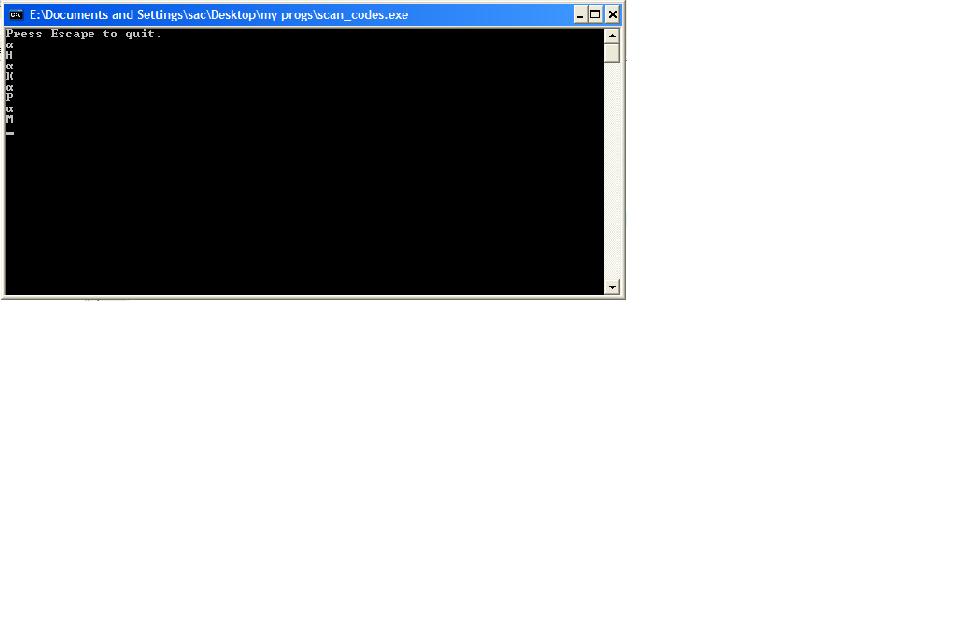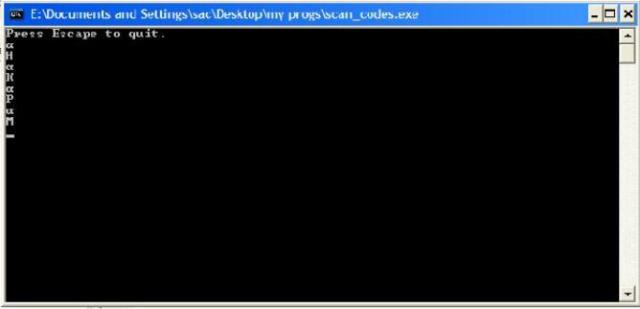I found the following code in the 'Code snippets' section( written by nanodano).
i tried compiling it in my Dev-Cpp compiler, and i got the output as shown in the attachment for up, left, down and right arrow keys respectively. All other defined keys i.e., F1 to F10 gave the proper output-although F11, F12, PageUp, Page Down, Home and End gave similar output as the arrow keys.
Also i didn't understand why we have to use getch() twice. Can someone explain, please?
/* This program shows how to pick up the scan codes from a keyboard */
/* These define the scan codes(IBM) for the keys. All numbers are in decimal.*/
#define PAGE_UP 73
#define HOME 71
#define END 79
#define PAGE_DOWN 81
#define UP_ARROW 72
#define LEFT_ARROW 75
#define DOWN_ARROW 80
#define RIGHT_ARROW 77
#define F1 59
#define F2 60
#define F3 61
#define F4 62
#define F5 63
#define F6 64
#define F7 65
#define F8 66
#define F9 67
#define F10 68
#include <iostream>
#include <conio.h>
using namespace std;
void main()
{
char KeyStroke;
cout << "Press Escape to quit." << endl;
do
{
KeyStroke = getch();
if (KeyStroke == 0)
{
KeyStroke = getch(); // Even though there are 2 getch() it reads one keystroke
switch (KeyStroke)
{
case PAGE_UP:
cout << "PAGE UP" << endl;
break;
case PAGE_DOWN:
cout << "PAGE DOWN" << endl;
break;
case HOME:
cout << "HOME" << endl;
break;
case END:
cout << "END" << endl;
break;
case UP_ARROW:
cout << "UP ARROW" << endl;
break;
case DOWN_ARROW:
cout << "DOWN ARROW" << endl;
break;
case LEFT_ARROW:
cout << "LEFT_ARROW" << endl;
break;
case RIGHT_ARROW:
cout << "RIGHT_ARROW" << endl;
break;
case F1:
cout << "F1" << endl;
break;
case F2:
cout << "F2" << endl;
break;
case F3:
cout << "F3" << endl;
break;
case F4:
cout << "F4" << endl;
break;
case F5:
cout << "F5" << endl;
break;
case F6:
cout << "F6" << endl;
break;
case F7:
cout << "F7" << endl;
break;
case F8:
cout << "F8" << endl;
break;
case F9:
cout << "F9" << endl;
break;
case F10:
cout << "F10" << endl;
break;
default:
cout << "Some other key." << endl;
}
}
else
cout << KeyStroke << endl;
}
while (KeyStroke != 27); // 27 = Escape key
}
